Abstract
An epidemiological study of 2153 workers in 15 West Yorkshire wool textile mills was conducted to determine relations between respiratory symptoms and exposure to inspirable wool mill dust. A questionnaire designed to elicit all the common respiratory symptoms was developed and tested, and administered to all workers willing to participate (85%). It was translated and administered in Urdu for the 385 workers from Pakistan whose English was not fluent. Symptoms investigated included cough and phlegm, wheezing and chest tightness, breathlessness and its variability, rhinitis, conjunctivitis, chills, nosebleeds, and chest illnesses. Additional questions were asked, where appropriate, about the times of day, days of the week, seasons, and places that the symptoms were worse or better than normal. An environmental survey was carried out at each mill, which included 629 measurements of inspirable dust, enabling estimates to be made of the airborne concentrations of inspirable dust usually experienced by each member of the workforce under current conditions. Overall symptom prevalences were: persistent cough and phlegm, 9%; wheeze, 31%; breathlessness on walking with others on level ground, 10%; persistent rhinitis, 18%; persistent conjunctivitis, 10%; persistent chills, 2%; ten or more nosebleeds a year, 2%; and three or more chest illnesses in past three years, 5%. After allowing for the effects of age, sex, smoking habit, and ethnic group, cough and phlegm, wheeze, breathlessness, rhinitis, conjunctivitis, and nosebleeds were found to be more frequent in those exposed to higher than to lower concentrations of dust. In some experiencing high concentrations (blenders and carpet yarn backwinders) cough and phlegm, wheeze, rhinitis, and conjunctivitis were related to the years worked in such jobs. Relative risks of each symptom in relation to inspirable dust concentrations were calculated by means of a logistic regression analysis. At concentrations of 10 mg/m3, the current United Kingdom standard for nuisance dusts, the risk of cough and phlegm relative to that of an unexposed worker was 1.37, that of wheeze 1.40, breathlessness 1.48, rhinitis 1.24, and conjunctivitis 1.70. Since some of these symptoms may be associated with functional impairment of the lungs, further studies of selected workers are being carried out to estimate the functional effects of exposure to dust in wool textile mills.
Full text
PDF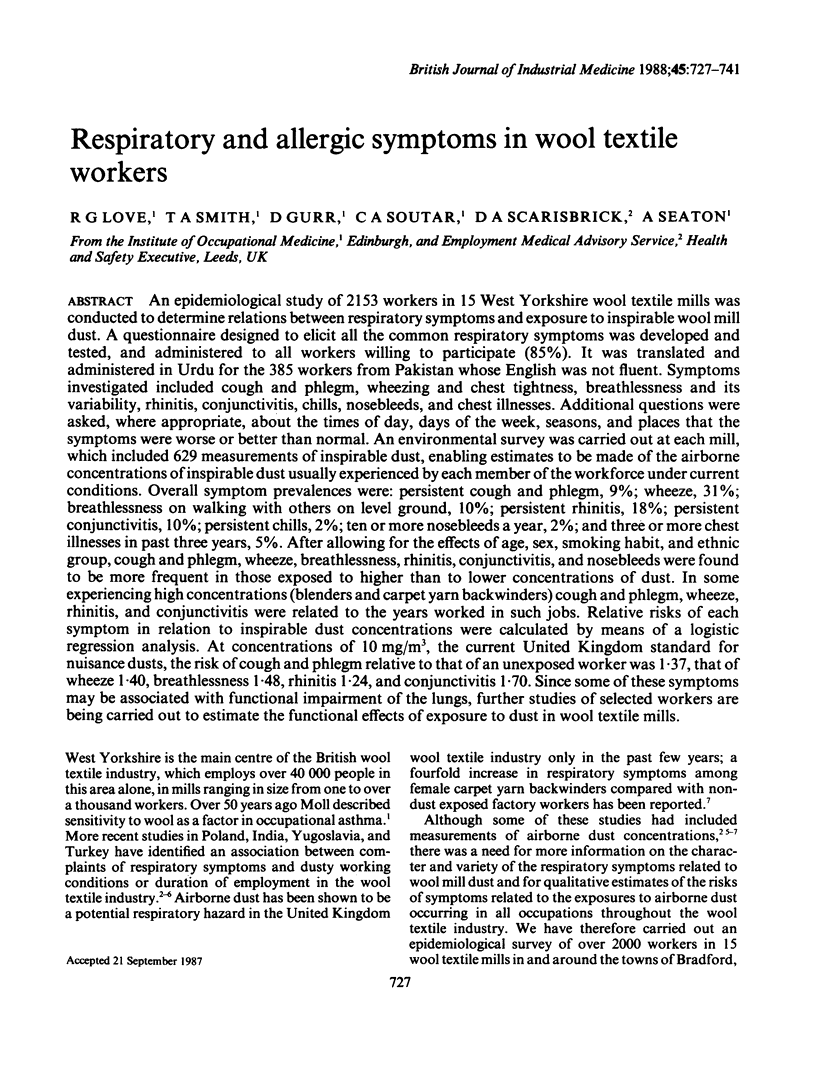

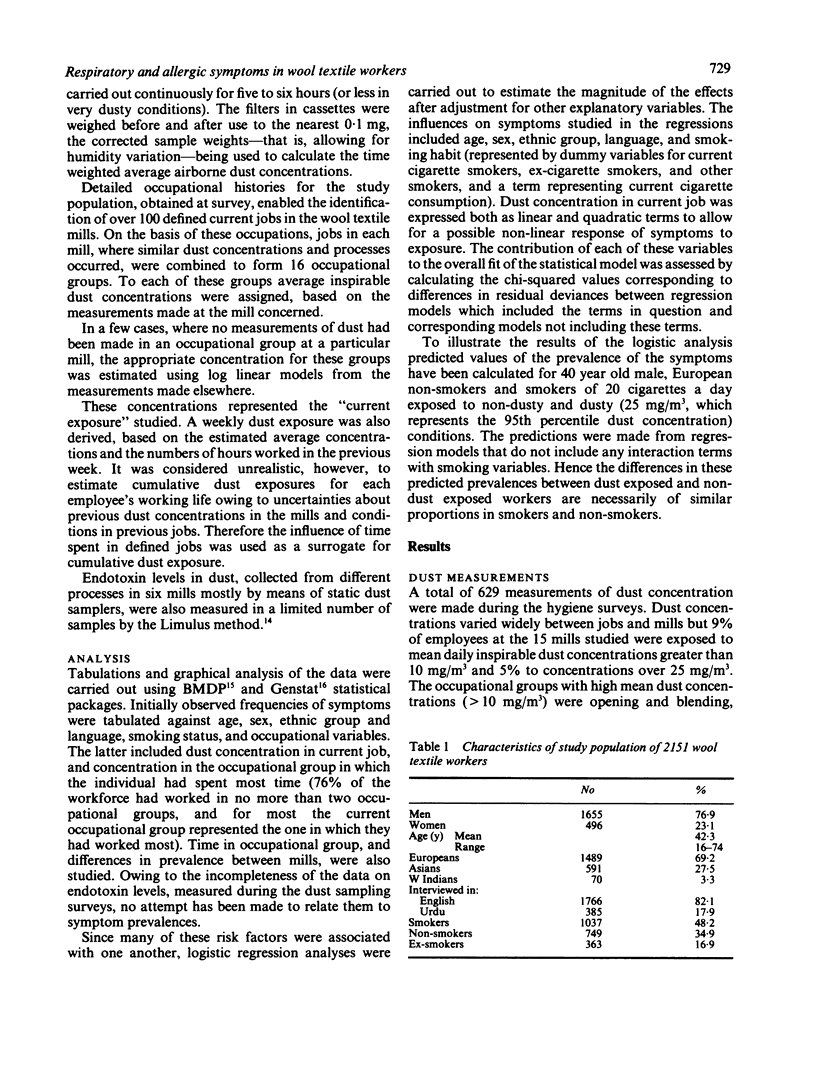
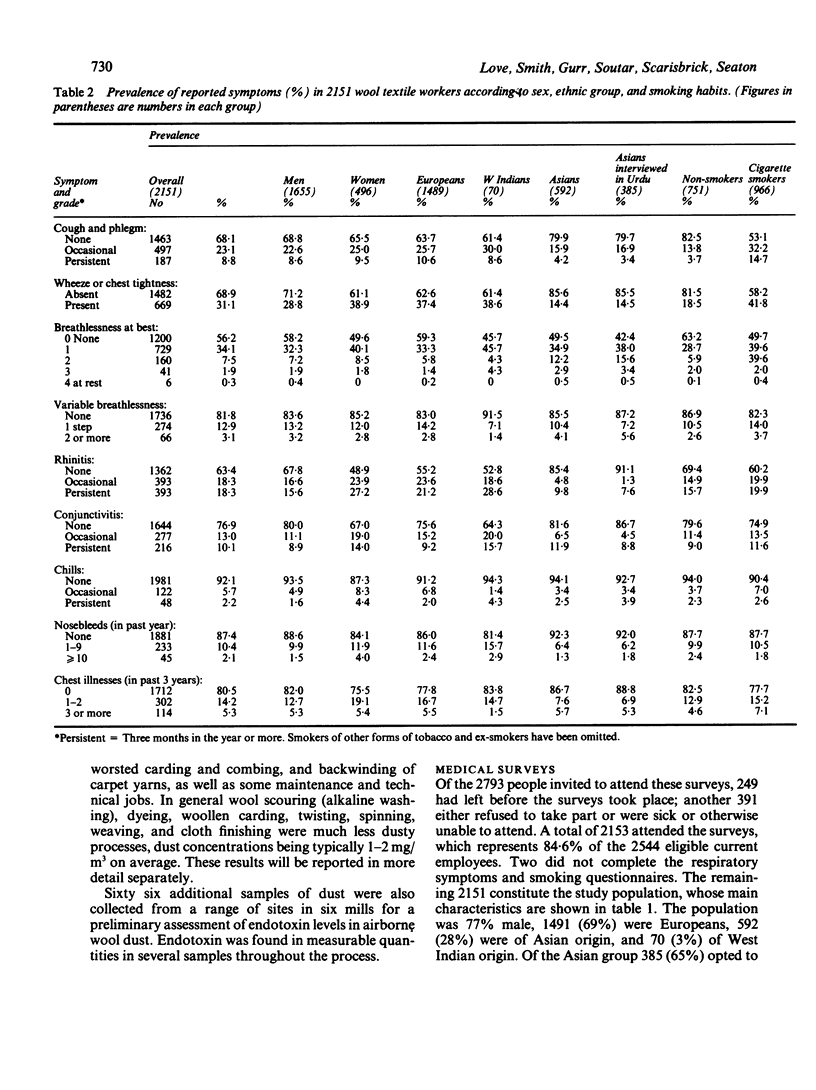
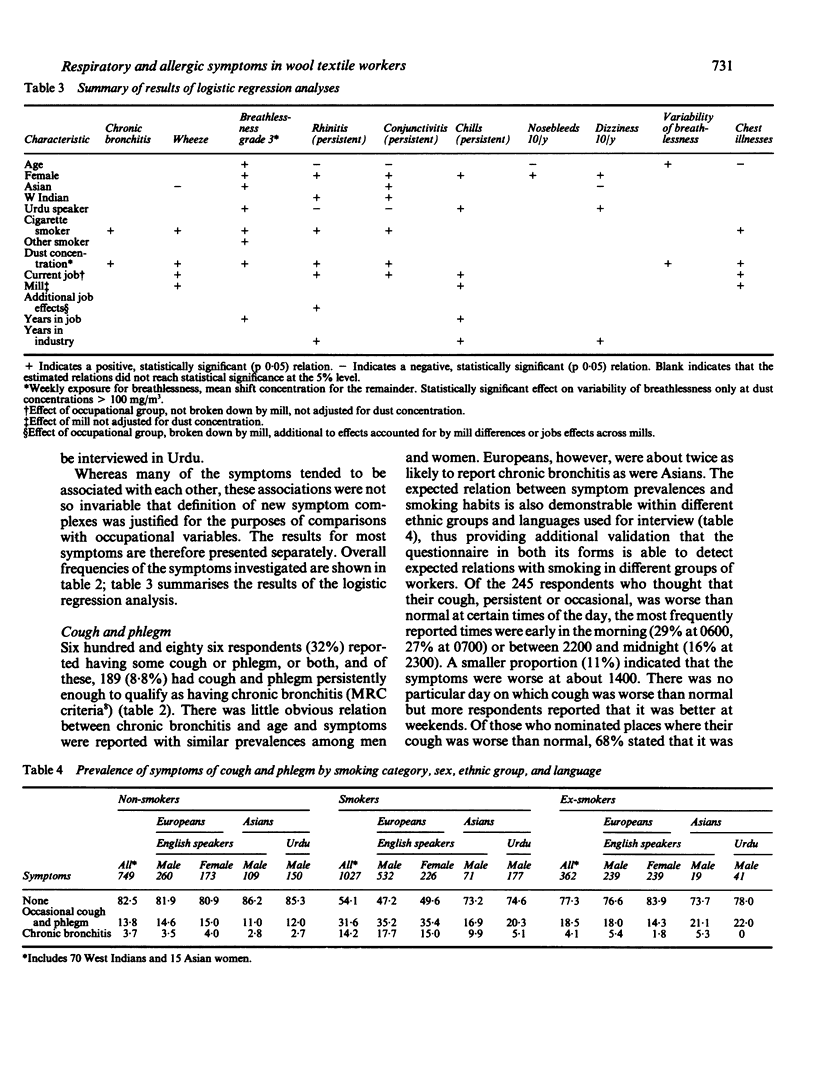
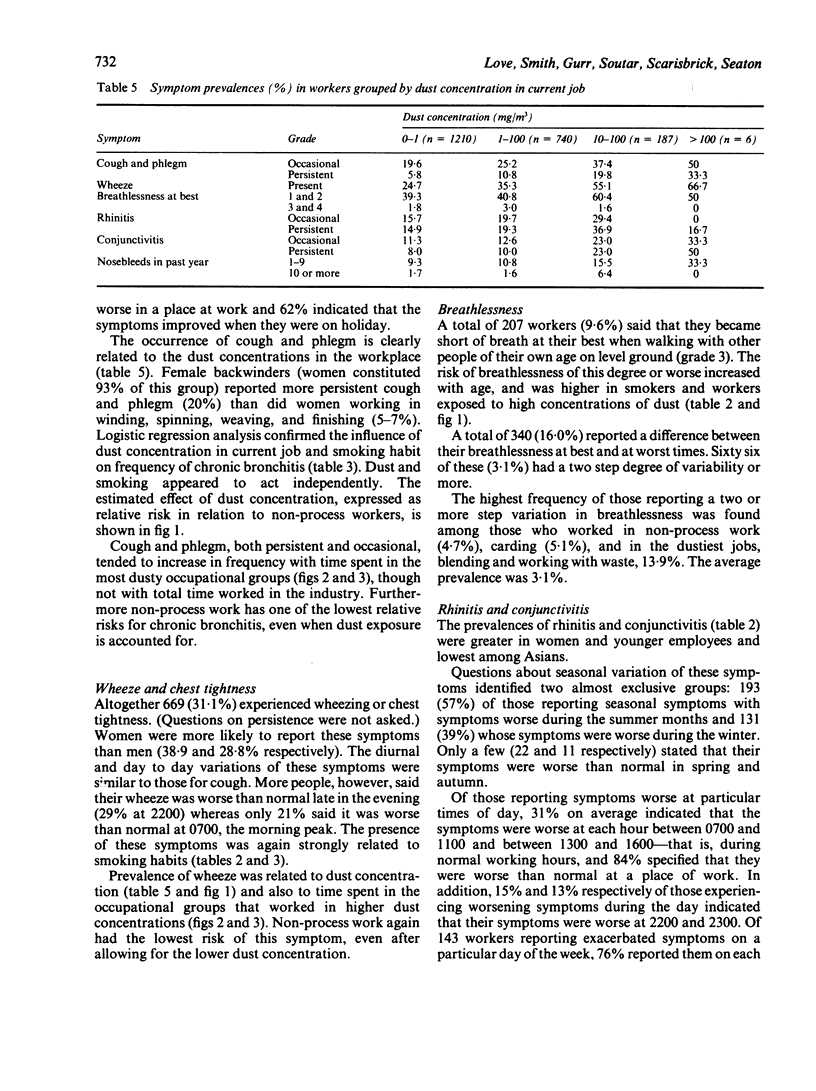
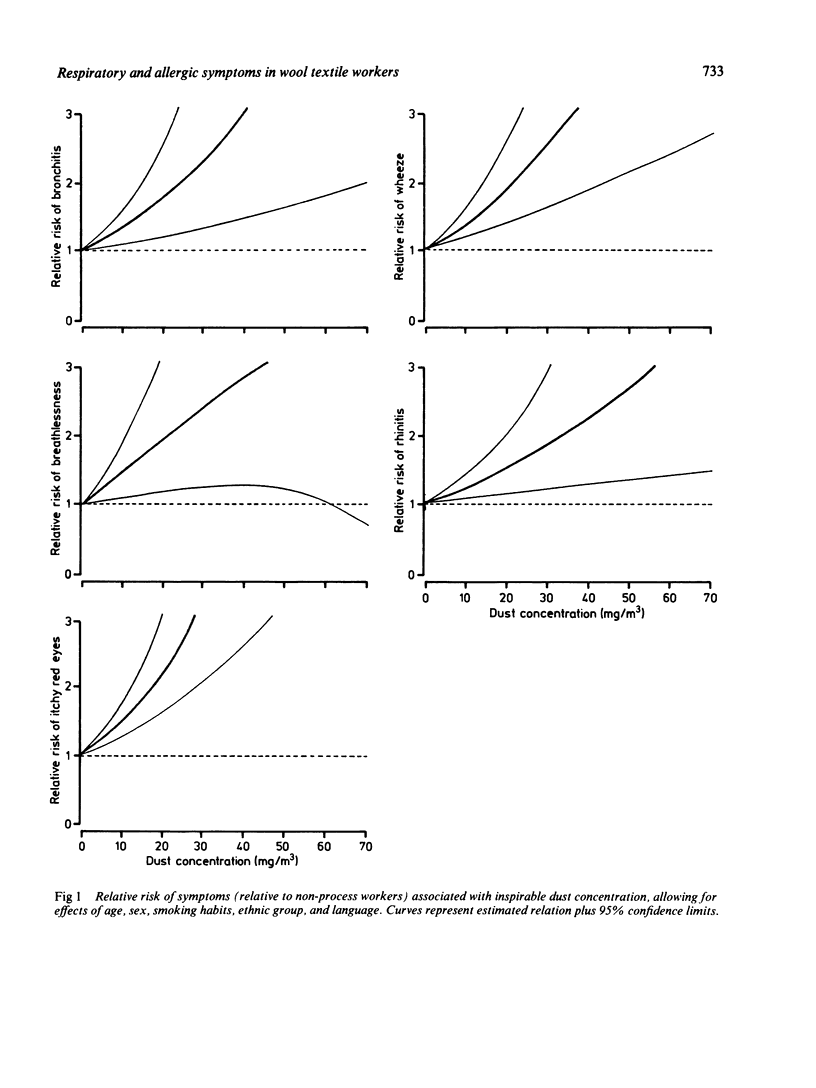

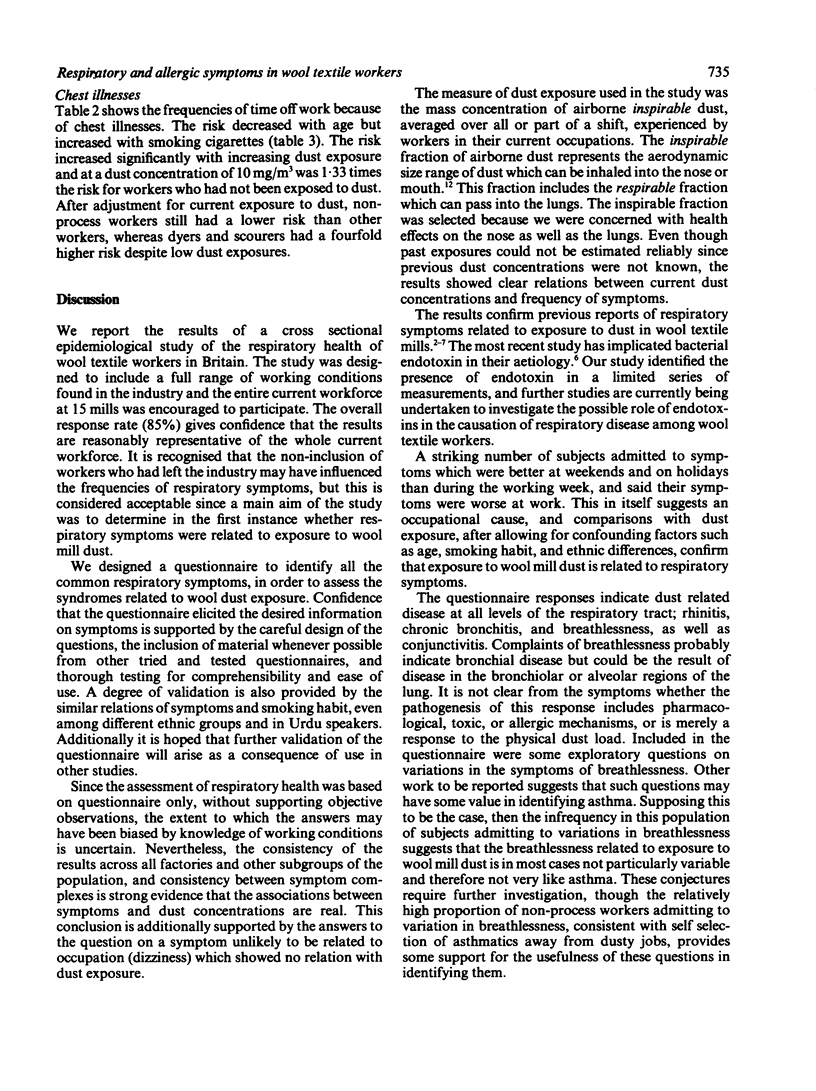
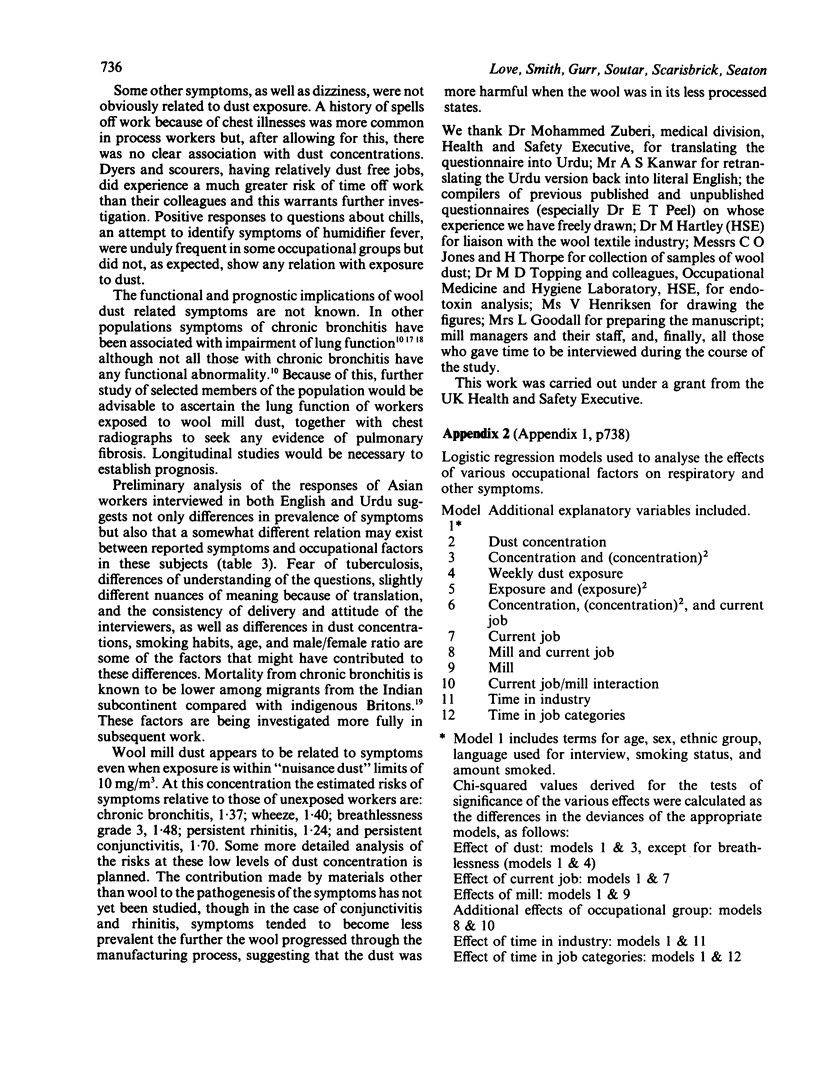
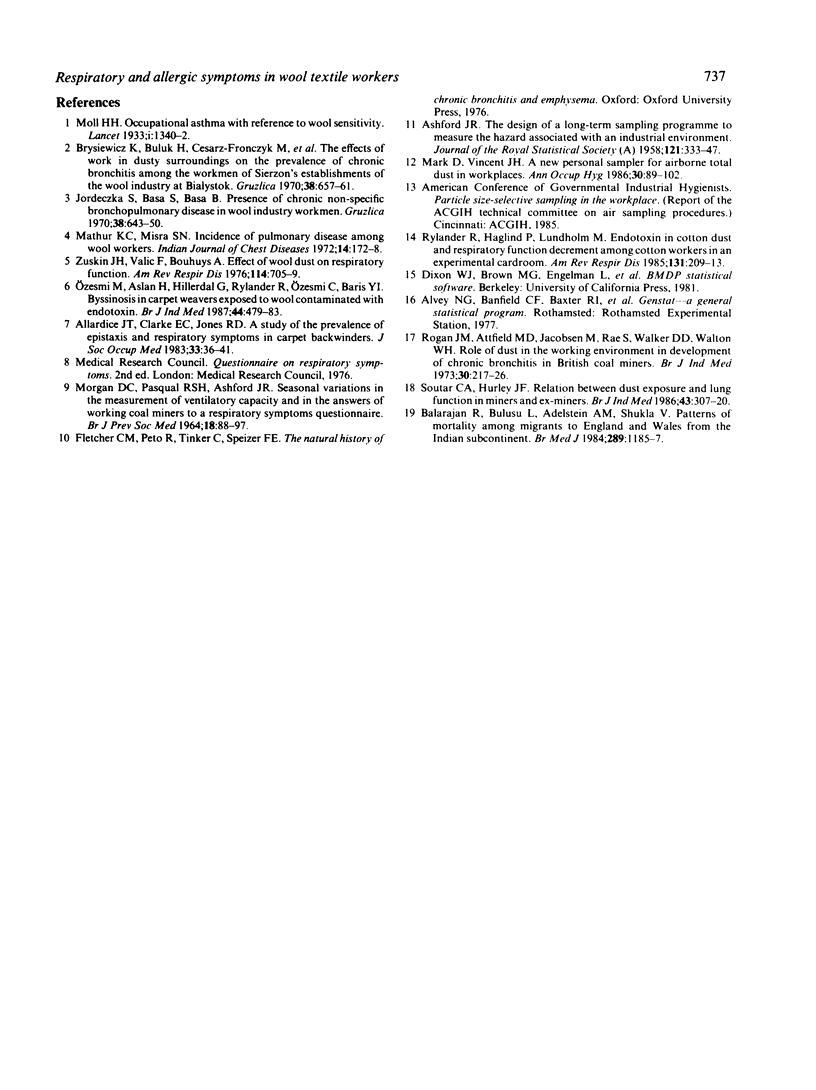
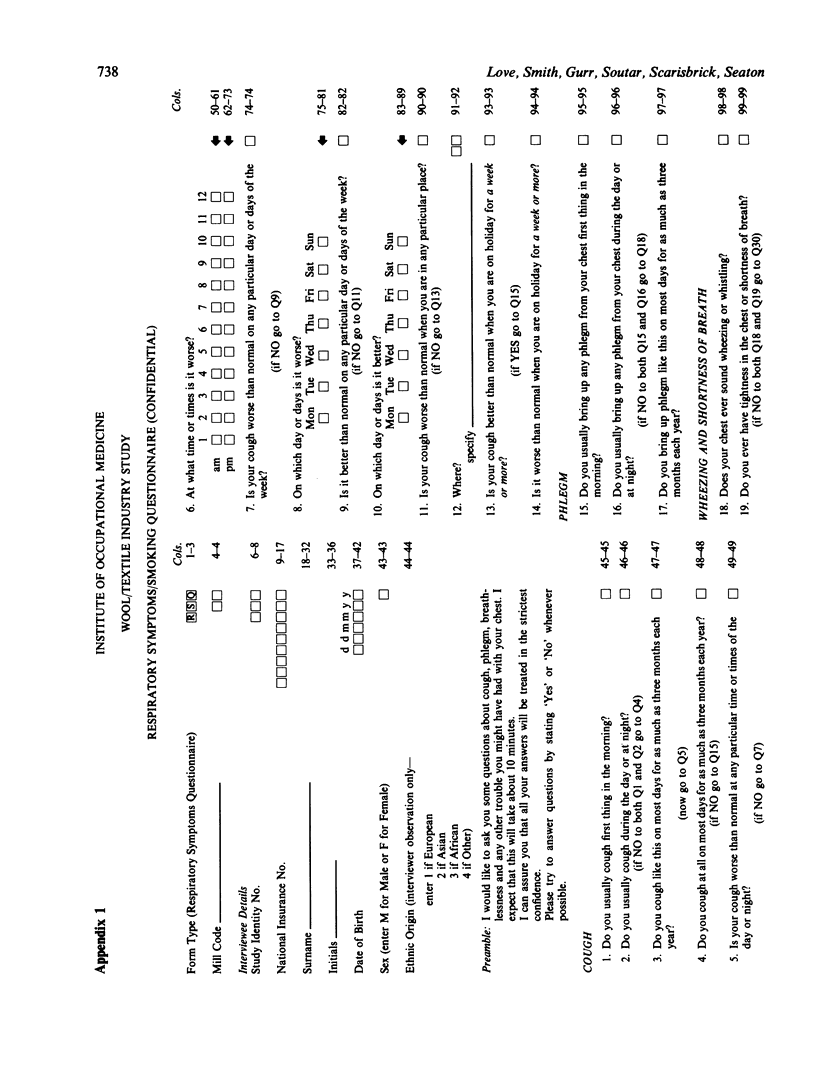
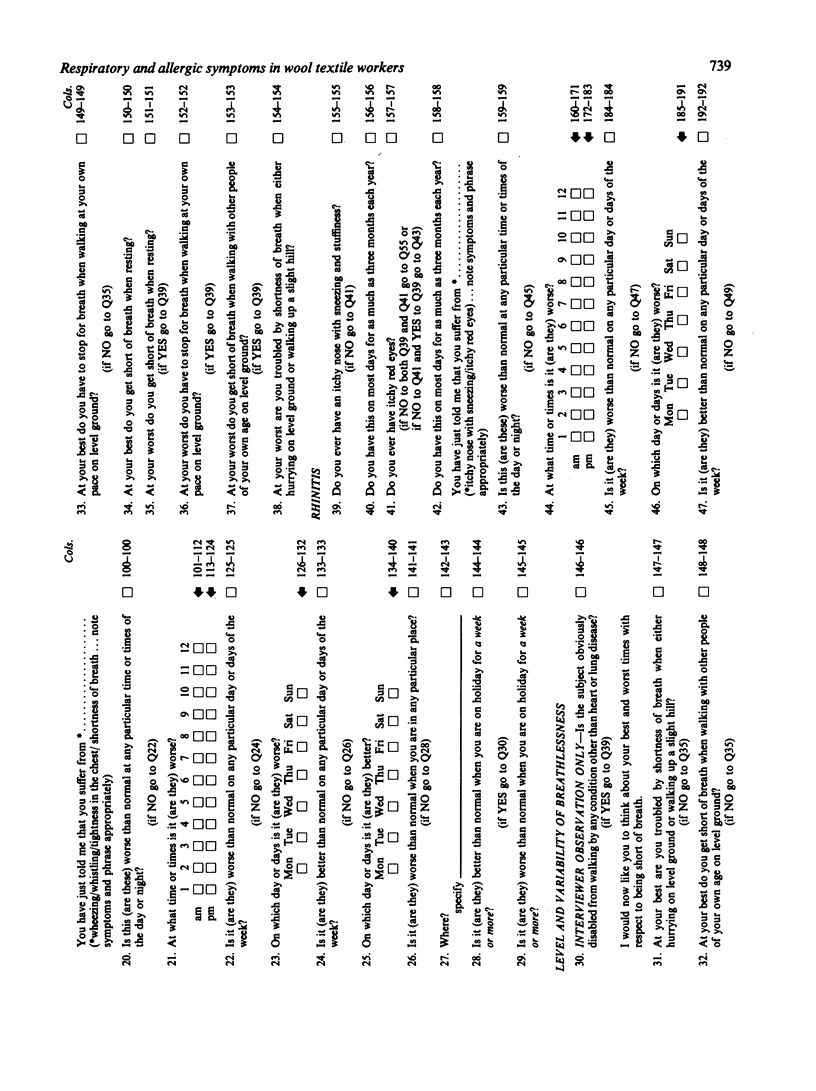
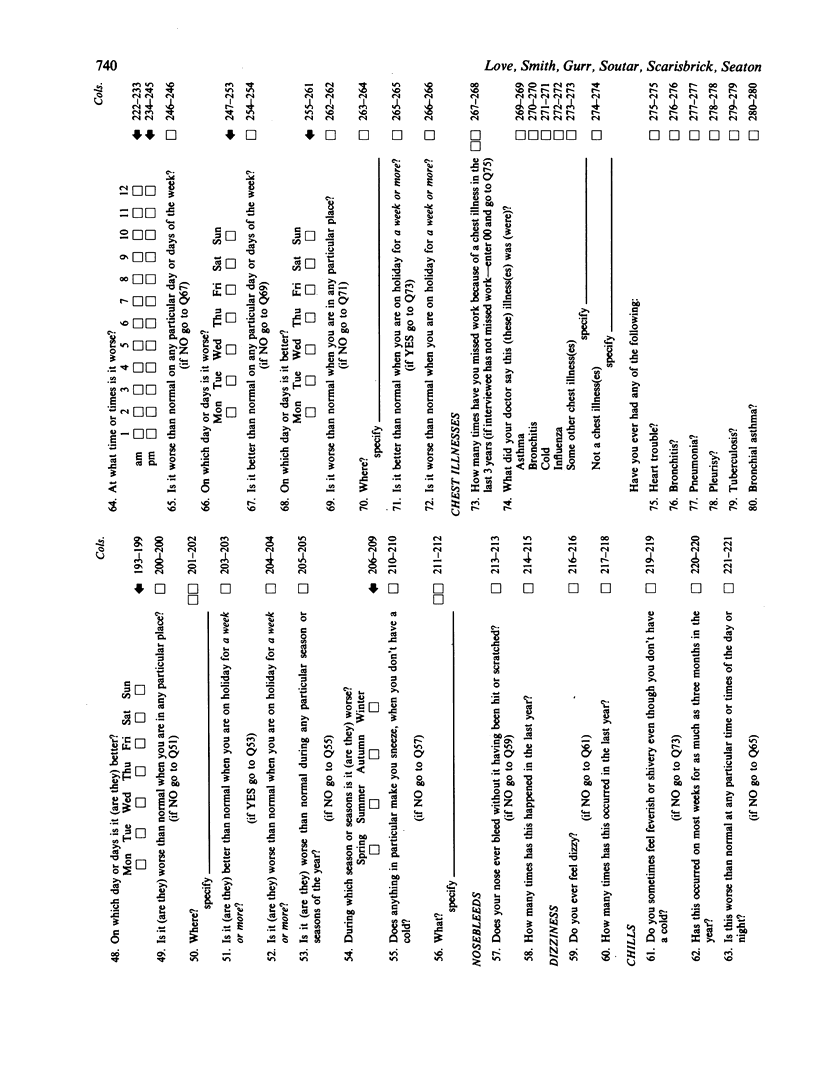
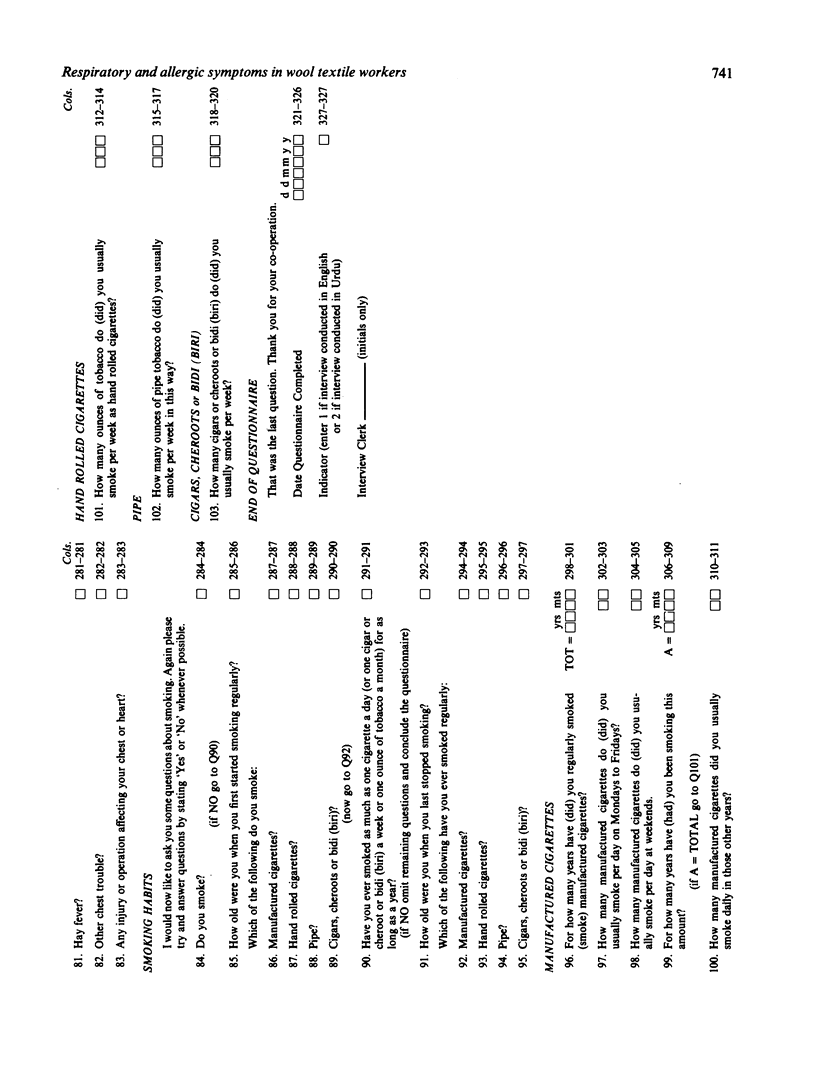
Selected References
These references are in PubMed. This may not be the complete list of references from this article.
- Allardice J. T., Clarke E. C., Jones R. D. A study of the prevalence of epistaxis and respiratory symptoms in carpet backwinders. J Soc Occup Med. 1983 Jan;33(1):36–41. doi: 10.1093/occmed/33.1.36. [DOI] [PubMed] [Google Scholar]
- Balarajan R., Bulusu L., Adelstein A. M., Shukla V. Patterns of mortality among migrants to England and Wales from the Indian subcontinent. Br Med J (Clin Res Ed) 1984 Nov 3;289(6453):1185–1187. doi: 10.1136/bmj.289.6453.1185. [DOI] [PMC free article] [PubMed] [Google Scholar]
- Brysiewicz K., Buluk H., Cesarz-Fronczyk M., Kordecka J., Leszczyński B., Lukjan Z., Sadokierska H. Wpływ pracy w warunkach zapylenia na czestoś wystepowania przewlekłych zapaleń oskrzeli u pracowników zakładów przemysłu wełnianego im. Sierzana w Białymstoku. Gruzlica. 1970;38(7):657–661. [PubMed] [Google Scholar]
- MORGAN D. C., PASQUAL R. S., ASHFORD J. R. SEASONAL VARIATIONS IN THE MEASUREMENT OF VENTILATORY CAPACITY AND IN THE ANSWERS OF WORKING COAL MINERS TO A RESPIRATORY SYMPTOMS QUESTIONARY. Br J Prev Soc Med. 1964 Apr;18:88–97. doi: 10.1136/jech.18.2.88. [DOI] [PMC free article] [PubMed] [Google Scholar]
- Mark D., Vincent J. H. A new personal sampler for airborne total dust in workplaces. Ann Occup Hyg. 1986;30(1):89–102. doi: 10.1093/annhyg/30.1.89. [DOI] [PubMed] [Google Scholar]
- Mathur K. C., Misra S. N. Incidence of pulmonary diseases among wool workers. Indian J Chest Dis. 1972 Jul;14(3):172–178. [PubMed] [Google Scholar]
- Ozesmi M., Aslan H., Hillerdal G., Rylander R., Ozesmi C., Baris Y. I. Byssinosis in carpet weavers exposed to wool contaminated with endotoxin. Br J Ind Med. 1987 Jul;44(7):479–483. doi: 10.1136/oem.44.7.479. [DOI] [PMC free article] [PubMed] [Google Scholar]
- Rogan J. M., Attfield M. D., Jacobsen M., Rae S., Walker D. D., Walton W. H. Role of dust in the working environment in development of chronic bronchitis in British coal miners. Br J Ind Med. 1973 Jul;30(3):217–226. doi: 10.1136/oem.30.3.217. [DOI] [PMC free article] [PubMed] [Google Scholar]
- Rylander R., Haglind P., Lundholm M. Endotoxin in cotton dust and respiratory function decrement among cotton workers in an experimental cardroom. Am Rev Respir Dis. 1985 Feb;131(2):209–213. doi: 10.1164/arrd.1985.131.2.209. [DOI] [PubMed] [Google Scholar]
- Soutar C. A., Hurley J. F. Relation between dust exposure and lung function in miners and ex-miners. Br J Ind Med. 1986 May;43(5):307–320. doi: 10.1136/oem.43.5.307. [DOI] [PMC free article] [PubMed] [Google Scholar]
- Zuskin E., Valic F., Bouhuys A. Effect of wool dust on respiratory function. Am Rev Respir Dis. 1976 Oct;114(4):705–709. doi: 10.1164/arrd.1976.114.4.705. [DOI] [PubMed] [Google Scholar]


